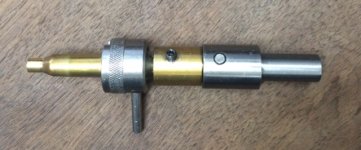I generally take two cuts to get down to whatever I want for neck thickness for a .262 or .263 neck chamber. On the first cut, I use a turning mandrel that has purposely been selected to have a slip on fit with no resistance. I do not force the feed and have no problems. Because of the mandrel to neck fit, I have no heat issues at all. For my final cut, which is around .001, I take a lot more care, the mandrel to neck fit requires just a little effort but little enough that with good lube, low RPMs and a carbide mandrel, I have no heat or brassing issues. My goal is to keep the cutter working all the time, and to let the case align itself with the tool without restraint. If it wants to wobble, I let it. Cutting to the shoulder I intentionally feed the case onto the mandrel too fast to make a clean cut, so that I leave some material to remove on the way back. This keeps the neck pinned to the mandrel all the time. On the way back to the case mouth I use a very slow feed, so that the finish quality is as good as possible, then I squeeze a wad of 0000 around the neck and spin the case faster for a second or so to make the finish more like it will be after firing, so that my measurement will be more accurate. I generally check necks as I go, because I don't do large numbers, and I want to catch problems when they happen. Generally, since switching to carbide mandrels for finish cuts, I have no problems, other than perhaps not having my cutter set for the exact thickness that I want. My necks' thickness are very uniform. Sometimes I have had discussions with shooters about neck turning to tight tolerances and have discovered that they were using a caliper. This is .0001 micrometer work..period. One little tip for those that are expanding .220 Russian cases up to 6mm, the PMA makes a long taper carbide mandrel that is very good for this. If you expand to the point where you feel the resistance climb to a certain point, reverse the ram a bit and repeat, doing this several times until the parallel part of the mandrel is fully in the neck, your necks will be as straight as they were when you started. (runout of about.002) of course a good lube is important to making this work. I use oil applied with a Q tip to the inside of the neck, and to the madrel at the beginning of a session. In my experience, if you expand with a single stroke, with typical mandrels, your cases' concentricity will suffer, and the cuts on their shoulders will be uneven.


